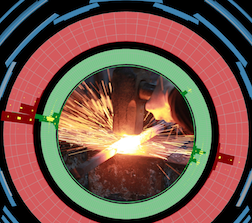New electroweak states appear in generic extensions of the Standard Model but are challenging to discover at hadron colliders. When the lightest state in a new electroweak multiplet is neutral and all multiplet components are approximately degenerate, production of the charged components is followed by decay into nearly invisible states. If this decay occurs promptly, the only way to infer the...
Interesting features in high energy physics data can be determined from properties of Voronoi tessellations of the relevant phase space. We focus on the detection of kinematic "edges" in two dimensions, which may signal physics beyond the standard model. After deriving some useful geometric results for Voronoi tessellations on perfect grids, we propose several algorithms for tagging the...
The lack of conclusive evidence for new physics in Run I of the LHC suggests that future discoveries may manifest themselves with small numbers of signal events. In this case, it will be crucial to use analysis techniques that extract as much information as possible from a limited number of events. Previously, a technique exploiting correlations in the full multi-particle phase space to...
If Supersymmetry (SUSY) is discovered at the LHC, it will be important to measure the masses and couplings as accurately as possible. Determining the precision with which the LHC can perform these measurements is important for understanding the road ahead, particularly in terms of complementarity between proposed colliders. We investigate the precision with which the gluino mass can be...
It is a possibility that the superworld (supersymmetric partners of our world) does exist without supersymmetry. The two worlds are being distinguished by an unbroken discrete Z_2 symmetry (similar to R-parity in supersymmetry). We lose the solution to the hierarchy problem. However, such a scenario has several motivations. For example, the lightest neutral superworld particle will be a...
Realizing that couplings related by supersymmetry (SUSY) can be disentangled when SUSY is broken, it is suggested that unwanted flavor and CP violating SUSY couplings may be suppressed via quenched gaugino-flavor interactions, which may be accomplished by power-law running of sfermion anomalous dimensions. A simple theoretical framework to accomplish this is exemplified and the defeated...
In the simplest SUSY extensions of the standard model, a 125 GeV Higgs motivates scalar masses in the tens of TeV range. However, scalar masses of this order are not large enough to immediately solve the SUSY flavor problem. At the same time, a WIMP solution to the dark matter problem motivates neutralino masses at or below a TeV. This suggests a micro-split spectrum with gaugino masses an...
We present a supersymmetric (SUSY) version of a two-field relaxion model that naturalizes supersymmetric models with high SUSY-breaking. This arises from a relaxion mechanism that does not depend on QCD dynamics and where the relaxion potential barrier height is controlled by a second axion-like field. During the cosmological evolution, the relaxion rolls with a nonzero value that breaks...
